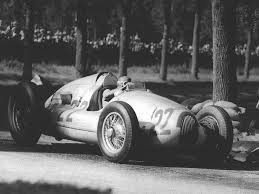
In the next five years (1926-1930) the 1.5 liter formula came into force reducing the minimum weight gradually from 600 kg (1926) by 700 kg (1927) do 550 kg w 1928 year. While in 1926 year, the new formula allowed only two-seater cars with one competitor, from 1927 year, it was also possible to use monoposto cars with a minimum width 850 mm. Initially, monoposts were constructed with the driver sitting on the right side, later the driver's seat was moved to the center of the car. W 1928 year has been established, that the competition should take place on a track of at least 600 km. A year later, the minimum weight was raised to 900 kg. The temporary reduction in weight was intended to attract more riders, because some races had less than nine participants.
The introduction of supercharged engines risked a disproportionate increase in fuel consumption for racing cars, therefore the formula of the year 1929 limited the maximum consumption to 14 kg of gasoline and diesel fuel per 100 km. W 1930 In the year, the formula allowed for adding gasoline to the commonly sold gasoline 30% benzene. Although these rules were established, some Grand Prix organizers had their own rules, not respecting the 1.5-liter formula. It has come to this, that even the official organization - the international sports commission of the CSI (International Sports Commission) the international association of recognized automobile clubs AIACR (International Association of Recognized Auto-mobile-Club) announced effective from 1931 year of Free Formula (Libra formula). The restrictions only applied to the organization of races. Due to the duration of the competition - over 10 hours – during the races, two drivers had to change at the wheel. As a result of the announcement of the Free Formula, the engine capacity and power of the cars increased excessively, however, in 1934 year, the international sports commission limited the maximum permissible weight of the car to 750 kg. It was the so-called. dry weight, that is, without fuel, oil, water, spare tools and wheels. At the same time, the minimum width of the body was set at 850 mm. In the last two pre-war years 1938-1939 a three-liter compressor formula was in force, defining the ratio of the capacity of compressor engines to non-compressor engines using the coefficient 1,5. The maximum displacement of the engine with the compressor was 3000 cm3, and without a compressor 4500 cm3. The minimum car weight was determined in proportion to the engine capacity. For the maximum capacity, this weight was 850 kg. It quickly turned out, that uncompressor-less cars designed exclusively by Delahaye and Talbot cannot compete with Mercedes compressor models in terms of power, Auto Union or Maserati. Therefore, the first post-war formula of the year 1947 changed the displacement ratio of compressor engines to atmospheric suction engines to 1 :3 with a capacity limitation to 1500 cm3, possibly 4500 cm3. Other technical parameters of the cars were not strictly defined. In years 1952-1953, when Ferrari cars reigned unrivaled on the Grand Prix circuits, Grand Prix cars have officially become formula automobiles 2. It was the so-called. two-liter formula with a capacity of up to 2000 cm3 without the use of a compressor.
The desire to bring racing car designs closer to those of series passenger cars led to the announcement of a new formula, introduced in 1954 year. It was a two and a half liter formula, in which the conversion factor to supercharged engines was 3,33. The capacity of the compressor engines was with this factor 750 cm3, which resulted in, that in years 1954-1960, when this formula was in force, cars with compressor practically disappeared from the racetrack. Completely new designs of engines with a capacity 2500 cm3 have used since 1958 year as aviation gasoline fuel and reached the rated power, tj. relating to 1 liter of engine volume, 73,5-88,2 kW / l (100-120 KM). These fantastic parameters were achieved thanks to the use of light alloys, and the ever more delicate cars had a weight 370 the 430 kg (Lotus, Cooper). Formula valid from 1961 year has therefore determined the minimum weight of the car on 450 kg (without fuel and driver). Engine capacity reduced to 1500 cm3. Increasingly stringent demands were made to increase driving safety. In addition to the dual-circuit brakes, seat belts and a protective arc above the driver were compulsory. Cars had to have an electric starter. The length of the racetrack is defined as 300-500 km.
It was the last formula requiring a classic open design, single-seater body with exposed wheels and drive from a piston internal combustion engine. In year 1966 period begins, in which the Grand Prix cars cannot be identified quickly and reliably, as it was before. Placing advertisements on car bodies, the disappearance of the tradition of marking cars with national colors, the placement of pressure wings and the possibility of using internal combustion turbines or Wankel engines radically changed the appearance of boxes and racetracks.
Overlapping commercial interests and colorful advertisements for tire manufacturers, oils, cosmetics, cigarettes or alcohol products caused, that this field of sport, which began with a gentlemanly competition, today it should be called Grand Circus rather than Grand Prix.